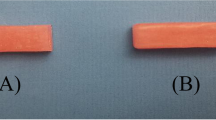Abstract
Fracture strength of denture base resins is of great concern and many approaches have been made to improve the fracture resistance of acrylic resin dentures by strengthening them. Purpose of the study was to assess the effect of a Novel pre-impregnated glass fiber reinforcement system and nylon fiber reinforcement on the flexural strength of conventional heat-polymerized poly(methylmethacrylate) [PMMA] denture resin under dry and wet storage conditions. Forty specimens of standard dimensions were prepared for each of the four experimental groups; unreinforced conventional acrylic resin and the same reinforced with unidirectional Stick (S) glass fibers, woven Stick Net (SN) glass fibers and nylon fibers. Each group was further subdivided into two groups of 20 specimens each on the basis of storage conditions (dry and wet). All 160 specimens were then subjected to a 3-point bending test and flexural strength was calculated. Statistical analysis was carried out using student t test and 1-way analysis of variance (ANOVA). Stick and Stick Net glass fiber reinforcements enhanced the flexural strength of conventional heat-cured PMMA denture resin. Specimens reinforced with Stick glass fibers exhibited highest flexural strength followed by those reinforced with Stick Net glass fibers. Nylon fiber reinforcement decreased the flexural strength of acrylic resin. All the specimens in the four groups stored under wet conditions showed decrease in flexural strength in comparison to those stored in dry conditions. The reinforcement of denture base resin with pre-impregnated glass fibers may be a useful means of strengthening denture bases. Use of nylon as a reinforcement fiber is not desirable as it decreased the flexural strength of acrylic resin.




Similar content being viewed by others
References
Peyton FA (1975) History of resins in dentistry. Dent Clin North Am 19:211–222
Smith DC (1962) Recent developments and prospects in dental polymers. J Prosthet Dent 12:1066–1078
Stafford GD, Smith DC (1970) Flexural fatigue tests of some denture base polymers. Br Dent J 128:442–445
Jagger DC, Harrison A, Jandt KD (1999) Review. The reinforcement of dentures. J Oral Rehabil 26:185–194
Stafford GD, Bates JF, Hugget R, Handley RW (1980) A review of the properties of some denture base polymers. J Dent 8:292–306
Ruffino AR (1985) Effect of steel strengtheners on fracture resistance of acrylic resin complete denture base. J Prosthet Dent 54:75–78
Vallittu PK, Lassila VP (1992) Reinforcement of acrylic resin denture base material with metal or fiber strengtheners. J Oral Rehabil 19:225–230
Solnit GS (1991) The effect of methyl methacrylate reinforcement with silane-treated and untreated glass fibers. J Prosthet Dent 66:310–314
Vallittu PK (1999) Flexural properties of acrylic resin polymers reinforced with unidirectional and woven glass fibers. J Prosthet Dent 81:318–326
Uzun G, Hersek N, Tincer T (1999) Effect of five woven fiber reinforcements on the impact and transverse strength of a denture base resin. J Prosthet Dent 81:616–620
John J, Shivaputrappa AG, Shah I (2001) Flexural strength of heat-polymerized polymethyl methacrylate denture resin reinforced with glass, aramid, or nylon fibers. J Prosthet Dent 86:424–427
Aydin C, Yilmaz H, Caglar A (2002) Effect of glass fiber reinforcement on the flexural strength of different denture base resins. Quintessence Int 33:457–463
Schreiber CK (1971) Polymethyl methacrylate reinforced with carbon fibers. Br Dent J 130:29–30
Manley TR, Bowman AJ, Cook M (1979) Denture bases reinforced with carbon fibers. Br Dent J 146:25
De Boer J, Vermilyea SG, Brady RE (1984) The effect of carbon fiber orientation on the fatigue resistance and bending properties of two denture resins. J Prosthet Dent 51:119–121
Kelly E (1969) Fatigue fracture in denture base polymers. J Prosthet Dent 21:257
Grant AA, Greener EH (1967) Whisker reinforcement of polymethyl methacrylate denture base resins. Aust Dent J 130:29–33
Dixon DL, Breeding LC (1992) The transverse strengths of three denture base resins reinforced with polyethylene fibers. J Prosthet Dent 67:417–419
Ramos V, Runyan DA, Christensen LC (1996) The effect of plasma-treated polyethylene fiber on the fracture strength of polymethyl methacrylate. J Prosthet Dent 76:94–96
Matthews E, Smith DC (1955) Nylon as a denture base material. Br Dent J 98:231–237
(1975) Revised American Dental Association specification no. 12 for denture base polymers. J Am Dent Assoc 90:451–458
Anusavice KJ (2003) Phillips science of dental materials, 11th edn. WB Saunders, St. Louis, pp 89–90
Vallittu PK (1994) Acrylic resin-fiber composite-part II: the effect of polymerization shrinkage of polymethyl methacrylate applied to fiber roving on transverse strength. J Prosthet Dent 71:613–617
Vallittu PK (1995) The effect of void space and polymerization time on transverse strength of acrylic-glass fiber composite. J Oral Rehabil 22:257–261
Vallittu PK (1999) The first symposium on fibre reinforced plastics in dentistry. University of Turku, Institute of Dentistry & Biomaterials Project, Finland, pp 4–14
Vallittu PK, Lassila VP, Lappalainen R (1994) Acrylic resin-fiber composite-part I: the effect of fiber concentration on fracture resistance. J Prosthet Dent 71:607–612
Brydson JA (1999) Relation of structure to chemical properties. In: Plastic materials, Butterworth-Heinemann, Oxford, pp 76–88
Schroeder E, Muller G Polymer characterization. Determination of solubility parameter. pp 306–311
Vallittu PK, Ruyter IE, Ekstrand K (1998) Effect of water storage on the flexural properties of E-glass and silica fibers acrylic resin composite. Int J Prosthodont 11:340–350
Vallittu PK (1997) Oxygen inhibition of autopolymerization of polymethyl methacrylate-glass fiber composite. J Mater Sci Mater Med 8:489–492
Source of support
The Novel glass fiber reinforcement system Stick (S) and Stick Net (SN) were funded by Stick Tech Ltd, Turku-Finland.
Conflicts of interest
None.
Author information
Authors and Affiliations
Corresponding author
Rights and permissions
About this article
Cite this article
Ladha, K., Shah, D. An In-Vitro Evaluation of the Flexural Strength of Heat-Polymerized Poly (Methyl Methacrylate) Denture Resin Reinforced with Fibers. J Indian Prosthodont Soc 11, 215–220 (2011). https://doi.org/10.1007/s13191-011-0086-5
Received:
Accepted:
Published:
Issue Date:
DOI: https://doi.org/10.1007/s13191-011-0086-5




